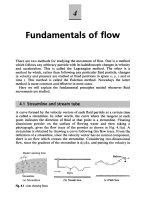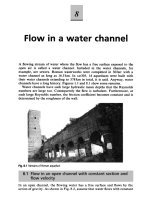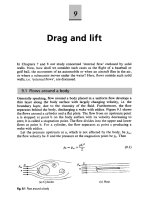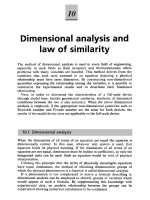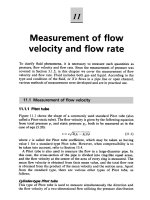Introduction to fluid mechanics - P2
Bạn đang xem bản rút gọn của tài liệu. Xem và tải ngay bản đầy đủ của tài liệu tại đây (566.65 KB, 14 trang )
Characteristics of a fluid
Fluids are divided into liquids and gases. A liquid is hard to compress and
as in the ancient saying ‘Water takes the shape of the vessel containing it’, it
changes its shape according to the shape of its container with an upper free
surface. Gas on the other hand is easy to compress, and fully expands to fill
its container. There is thus no free surface.
Consequently, an important characteristic of a fluid from the viewpoint
of fluid mechanics is its compressibility. Another characteristic is its viscosity.
Whereas a solid shows its elasticity in tension, compression or shearing stress,
a fluid does so only for compression. In other words, a fluid increases its
pressure against compression, trying to retain its original volume. This
characteristic is called compressibility. Furthermore, a fluid shows resistance
whenever two layers slide over each other. This characteristic is called
viscosity.
In general, liquids are called incompressible fluids and gases compressible
fluids. Nevertheless, for liquids, compressibility must be taken into account
whenever they are highly pressurised, and for gases compressibility may be
disregarded whenever the change in pressure is small. Although a fluid is an
aggregate of molecules in constant motion, the mean free path of these
molecules is 0.06pm or so even for air of normal temperature and pressure,
so a fluid is treated as a continuous isotropic substance.
Meanwhile, a non-existent, assumed fluid without either viscosity or compressibility is called an ideal fluid or perfect fluid. A fluid with compressibility
but without viscosity is occasionally discriminated and called a perfect fluid,
too. Furthermore, a gas subject to Boyle’s-Charles’ law is called a perfect or
ideal gas.
A 1 physical quantities are given by a few fundamental quantities or their
1
combinations. The units of such fundamental quantities are called base
Units and dimensions 7
units, combinations of them being called derived units. The system in which
length, mass and time are adopted as the basic quantities, and from which
the units of other quantities are derived, is called the absolute system of
units.
2.2.1 Absolute system of units
MKS system of units
This is the system of units where the metre (m) is used for the unit of length,
kilogram (kg) for the unit of mass, and second (s) for the unit of time as the
base units.
CGS system of units
This is the system of units where the centimetre (cm) is used for length,
gram (g) for mass, and second (s) for time as the base units.
International system of units (SI?
SI, the abbreviation of La Systkme International d’Unites, is the system
developed from the MKS system of units. It is a consistent and reasonable
system of units which makes it a rule to adopt only one unit for each of
the various quantities used in such fields as science, education and
industry.
There are seven fundamental SI units, namely: metre (m) for length,
kilogram (kg) for mass, second (s) for time, ampere (A) for electric
current, kelvin (K) for thermodynamic temperature, mole (mol) for mass
quantity and candela (cd) for intensity of light. Derived units consist of
these units.
Table 2.1 Dimensions and units
Quantity
Absolute system of units
a
Length
Mass
Time
Velocity
Acceleration
Density
Force
Pressure, stress
Energy, work
Viscosity
Kinematic viscosity
B
Y
units
1
0
0
1
0
1
0
0
0
0
0
1
m
kg
1
-3
-1
1
1
1
1
1
2
0
1
-1
2
-1
-2
0
-2
-2
-2
-1
-1
S
mls
m/s2
kg I m3
N = kg m/s2
Pa = N/m2
J
Pa s
m2/s
8 Characteristics of a fluid
2.2.2 Dimension
All physical quantities are expressed in combinations of base units. The index
number of the combination of base units expressing a certain physical
quantity is called the dimension, as follows.
In the absolute system of units the length, mass and time are
respectively expressed by L, M and T. Put Q as a certain physical
quantity and c as a proportional constant, and assume that they are
expressed as follows:
where a, /3 and y are respectively called the dimensions of Q for L, M, T.
Table 2.1 shows the dimensions of various quantities.
The mass per unit volume of material is called the density, which is
generally expressed by the symbol p. The density of a gas changes according
to the pressure, but that of a liquid may be considered unchangeable in
general. The units of density are kg/m3 (SI). The density of water at 4°C
and 1 atm (101 325 Pa, standard atmospheric pressure; see Section 3.1.1) is
1000kg/m3.
The ratio of the density of a material p to the density of water p , is called
the specific gravity, which is expressed by the symbol s:
The reciprocal of density, i.e. the volume per unit mass, is called the specific
volume, which is generally expressed by the symbol u:
Values for the density p of water and air under standard atmospheric
pressure are given in Table 2.2.
Table 2.2 Density of water and air (standard atmospheric pressure)
Temperature ("C)
p (kg/m')
Water
Air
0
10
999.8
1.293
999.7 999.1 998.2
1.247 1.226 1.205
15
20
100
40
60
80
992.2
1.128
983.2
1.060
971.8 958.4
1.000 0.9464
Viscosity 9
As shown in Fig. 2.1, suppose that liquid fills the space between two parallel
plates of area A each and gap h, the lower plate is fixed, and force F is needed
to move the upper plate in parallel at velocity U . Whenever U h / v < 1500
(v = p / p : kinematic viscosity), laminar flow (see Section 4.4) is maintained,
and a linear velocity distribution, as shown in the figure, is obtained. Such a
parallel flow of uniform velocity gradient is called the Couette flow.
In this case, the force per unit area necessary for moving the plate, i.e.
the shearing stress (Pa), is proportional to U and inversely proportional to h.
Using a proportional constant p, it can be expressed as follows:
F
U
T = -A p - h
=
(2.4)
The proportional constant p is called the viscosity, the coefficient of viscosity
or the dynamic viscosity.
Fig. 2.1 Couette flow
Fig. 2.2 Flow between parallel plates
10 Characteristics of a fluid
Isaac Newton (1642-1 727)
English mathematician, physicist and astronomer;
studied at the University of Cambridge. His three
big discoveries of the spectral analysis of light,
universal gravitation and differential and integral
calculus are only too well known. There are so
many scientific terms named after Newton
(Newton's rings and Newton's law of motion/
viscosity/resistance) that he can be regarded as the
greatest contributor to the establishment of
modern natural science.
Newton's statue at Grantham near Woolsthorpe, his birthplace
Such a flow where the velocity u in the x direction changes in the y
direction is called shear flow. Figure 2.1 shows the case where the fluid in the
gap is not flowing. However, the velocity distribution in the case where the
fluid is flowing is as shown in Fig. 2.2. Extending eqn (2.4) to such a flow, the
shear stress z on the section dy, distance y from the solid wall, is given by
the following equation:
z=p-
du
dY
This relation was found by Newton through experiment, and is called
Newton's law of viscosity.
Viscosity 11
Fig. 2 3 Change in viscosity of air and of water under 1 atm
.
In the case of gases, increased temperature makes the molecular movement
more vigorous and increases molecular mixing so that the viscosity increases.
In the case of a liquid, as its temperature increases molecules separate from
each other, decreasing the attraction between them, and so the viscosity
decreases. The relation between the temperature and the viscosity is thus
reversed for gas and for liquid. Figure 2.3 shows the change with temperature
of the viscosity of air and of water.
The units of viscosity are Pa s (pascal second) in SI, and g/(cm s) in the
CGS absolute system of units. lg/(cm s) in the absolute system of units is
called 1 P (poise) (since Poiseuille’s law, stated in Section 6.3.2, is utilised for
measuring the viscosity, the unit is named after him), while its 1/100th part
is 1 CP(centipoise). Thus
1 P = lOOcP = 0.1 Pas
The value v obtained by dividing viscosity p by density p is called the
kinematic viscosity or the coefficient of kinematic viscosity:
v = -P
P
(2.6)
Since the effect of viscosity on the movement of fluid is expressed by v, the
name of kinematic viscosity is given. The unit is m2/sregardless of the system
of units. In the CGS system of units 1 cm2/s is called 1 St (stokes) (since
12 Characteristics of a fluid
Table 2.3 Viscosity and kinematic viscosity of water and air at standard atmospheric pressure
Water
Temp.
A i
(“C)
Viscosity, p
(Pas x 10’)
Kinematic
viscosity, v
(m2/s x lo6)
Viscosity, p
(Pas x io5)
Kinematic
viscosity, v
(m2/s x106)
0
10
20
30
40
179.2
130.7
100.2
79.7
65.3
1.792
1.307
1.004
0.801
0.658
1.724
1.773
1.822
1.869
1.915
13.33
14.21
15.12
16.04
16.98
Stokes’ equation, to be stated in Section 9.3.3, is utilised for measuring the
viscosity, it is named after him), while its 1/ 100th part is 1 cSt (centistokes).
Thus
I s t = 1 x 10-~mz/S
1 cSt = 1 x 10Pm2/s
The viscosity p and the kinematic viscosity v of water and air under standard
atmospheric pressure are given in Table 2.3.
The kinematic viscosity v of oil is approximately 30-100 cSt. Viscosity
Fig. 2.4 Rheological diagram
Surface tension 13
sensitivity to temperature is expressed by the viscosity index VI,' a
non-dimensional number. A VI of 100 is assigned to the least temperature
sensitive oil and 0 to the most sensitive. With additives, the VI can exceed
100. While oil is used under high pressure in many cases, the viscosity of oil is
apt to increase somewhat as the pressure increases.
For water, oil or air, the shearing stress z is proportional to the
velocity gradient duldy. Such fluids are called Newtonian fluids. On the
other hand, liquid which is not subject to Newton's law of viscosity, such
as a liquid pulp, a high-molecular-weight solution or asphalt, is called a
non-Newtonian fluid. These fluids are further classified as shown in Fig.
2.4 by the relationship between the shearing stress and the velocity
gradient, i.e. a rheological diagram. Their mechanical behaviour is
minutely treated by rheology, the science allied to the deformation and
flow of a substance.
The surface of a liquid is apt to shrink, and its free surface is in such a state
where each section pulls another as if an elastic film is being stretched. The
tensile strength per unit length of assumed section on the free surface is called
the surface tension. Surface tensions of various kinds of liquid are given in
Table 2.4.
As shown in Fig. 2.5, a dewdrop appearing on a plant leaf is spherical in
shape. This is also because of the tendency to shrink due to surface tension.
Consequently its internal pressure is higher than its peripheral pressure.
Putting d as the diameter of the liquid drop, T as the surface tension, and p as
the increase in internal pressure, the following equation is obtained owing
to the balance of forces as shown in Fig. 2.6:
nd2
ndT = -Ap
4
or
Ap = 4 T / d
The same applies to the case of small bubbles in a liquid.
Table 2.4 Surface tension of liquid (20°C)
Liquid
N/m
Water
Mercury
Mercury
Methyl alcohol
'
Surface liquid
Air
Air
Water
Air
0.0728
0.476
0.373
0.023
I S 0 2909-1981
14 Characteristics of a fluid
Fig. 2.5 A dewdrop on a taro leaf
Whenever a fine tube is pushed through the free surface of a liquid, the
liquid rises up or falls in the tube as shown in Fig. 2.7 owing to the relation
between the surface tension and the adhesive force between the liquid and the
solid. This phenomenon is called capillarity. As shown in Fig. 2.8, d is the
diameter of the tube, 8 the contact angle of the liquid to the wall, p the
density of liquid, and h the mean height of the liquid surface. The following
equation is obtained owing to the balance between the adhesive force of
liquid stuck to the wall, trying to pull the liquid up the tube by the surface
tension, and the weight of liquid in the tube:
Xd2
ndT COS 8 = - p g h
4
or
4T cos 8
h=Pgd
Fig. 2.6 Balance between the pressure increase within a liquid drop and the surface tension
(2.8)
Surface tension 15
(a) Water
(b) Mercury
Fig. 2.7 Change of liquid surface due to capillarity
Whenever water or alcohol is in direct contact with a glass tube in air under
normal temperature, 8 2: 0. In the case of mercury, 8 = 130"-150". In the case
where a glass tube is placed in liquid,
for water
h = 30/d
for alcohol h = 11.6/d
(2.9)
for mercury h = -1O/d
(in mm). Whenever pressure is measured using a liquid column, it is necessary
to pay attention to the capillarity correction.
I
Fig. 2.8 Capillarity
16 Characteristics of a fluid
As shown in Fig. 2.9, assume that fluid of volume V at pressure p decreased
its volume by A V due to the further increase in pressure by Ap. In this case,
since the cubic dilatation of the fluid is AV/V, the bulk modulus K is
expressed by the following equation:
K=- AP
AV/V=-"-
dP
dV
(2.10)
Its reciprocal B
B=
l/K
(2.1 1)
is called the compressibility, whose value directly indicates how compressible
the fluid is. For water of normal temperature/pressure K = 2.06 x lo9Pa,
and for air K = 1.4 x los Pa assuming adiabatic change. In the case of water,
B = 4.85 x lo-'' l/Pa, and shrinks only by approximately 0.005% even if the
atmospheric pressure is increased by 1 atm.
Putting p as the fluid density and M as the mass, since p V = M = constant,
assume an increase in density Ap whenever the volume has decreased by AV,
and
K = p - AP p*
=
(2.12)
AP
dP
The bulk modulus K is closely related to the velocity a of a pressure wave
propagating in a liquid, which is given by the following equation (see
Section 13.2):
.=&=E
Fig. 2.9 Measuring of bulk modulus of fluid
(2.13)
Characteristics of a perfect gas 17
Table 2.5 Gas constant Rand ratio of specific heat K
Helium
Air
Carbon monoxide
Oxygen
Hydrogen
Carbon dioxide
Methane
Symbol
He
-
CO
0 2
H
2
COZ
CH,
R (SI)
m*/(s* K)
K
(OOC, 760 mm H )
g
Gas
0.178 5
1.293
1.250
0.089 9
1.429
1.977
0.717
2078.1
287.1
296.9
4 124.8
259.8
189.0
518.7
1.66
1.402
1.400
1.409
1.399
1.301
1.319
Density (kg/m3)
= CJC,
Let p be the pressure of a gas, u the specific volume, T the absolute
temperature and R the gas constant. Then the following equation results from
Boyle’s-Charles’ law:
p v = RT
(2.14)
This equation is called the equation of state of the gas, and v = l/p (SI) as
shown in eqn (2.3). The value and unit of R varies as given in Table 2.5.
A gas subject to eqn (2.14) is called a perfect gas or an ideal gas. Strictly
speaking, all real gases are not perfect gases. However, any gas at a
considerably higher temperature than its liquefied temperature may be
regarded as approximating to a perfect gas.
Fig. 2.10 State change of perfect gas
18 Characteristicsof a fluid
The change in state of a perfect gas is expressed by the following
equation:
pv" = constant
where n is called the polytropic exponent. As this value changes from 0 to
00, as shown in Fig. 2.10, the state of gas makes five kinds of changes known
as isobaric, isothermal, polytropic, adiabatic and isochoric changes. In
particular, in the case of adiabatic change, n = K is obtained. Here K is the
ratio of specific heat at constant pressure c, to specific heat at constant
volume c,, called the ratio of specific heats (isentropic index). Its value for
various gases is given in Table 2.5.
1. Derive the SI unit of force from base units.
2. Express the viscosity and the kinematic viscosity in SI units.
3. The density of water at 4°C and 1 atm is 1000 kg/m3. Obtain the specific
volume u under such conditions.
4. Obtain the pressure in SI (Pa) necessary for shrinking the volume of water
by 1% at normal temperature and pressure. Assume the compressibility
of water B = 4.85 x lo-'' 1 /Pa.
5. When two plates are placed vertically on liquid as shown in Fig. 2.1 1,
derive the equation showing the increased height of the liquid surface
between the plates due to capillarity. Also when flat plates of glass are
used with a l m m gap, what is the increased height of the water
surface?
Fig. 2.11
Problems 19
6 . Water at 20°C contains a bubble of diameter 1 mm. How much higher is
the internal pressure of this bubble compared with the outside pressure?
7. How much force is necessary to lift a ring, diameter 20mm, made of fine
wire, and placed on the surface of water at 20°C?
8. As shown in Fig. 2.12, a cylinder of diameter 122mm and length 200mm
is placed inside a concentric long pipe of diameter 125 mm. An oil film is
introduced in the gap between the pipe and the cylinder. What force is
necessary to move the cylinder at a velocity of l m / s ? Assume that the
dynamic viscosity of oil is 30 cSt and the specific gravity is 0.9.
Fig. 2.12
9. Calculate the velocity of sound propagating in water at 20°C. Assume that
the bulk modulus of water K = 2.2 x lo9Pa.


